As I’ve mentioned in the last few posts, my Dad joined me for a couple weeks in Việt Nam and together we traveled from the capital Hà Nội in the north to the southern metropolis Hồ Chí Minh City. This was a great opportunity for us to spend some time together, and also a chance for Dad to visit a country that he has heard stories about his whole life. I invited him to write a guest post for the blog to share his impressions of Việt Nam and provide a different perspective. So without further ado, here it is!
Being somewhat of a history buff, and with two uncles who served in Vietnam during the war, I have always been intrigued by this country. However, being on the other side of the planet, I never really had the occasion to swing through for a visit. The light went on when Aaron decided that he was going to take a little sabbatical and spend time traveling through Southeast Asia and India. What a perfect excuse to visit Vietnam while spending time with Aaron doing what he really loves doing! So after plotting out a two week itinerary to explore Vietnam, I set off on Friday the 13th of April, unsure of what to expect other than an interesting adventure. As it turned out, it was that and more!
I arrived in Hanoi via Taipei after a long, but pleasant, trip. The first thing you notice when coming into Hanoi, and something that would amaze me for the entire trip, was the large number of motorcycles. It seemed quite chaotic and they moved almost like a swarm. My first impression was that it was just madness. However, I came to realize after watching and experiencing this mode of transportation, this was the only way to keep this city of eight million from becoming totally gridlocked. In fact, throughout the entire country, this was the primary mode of transportation. After a while, I came to appreciate the beauty in the madness.
Travelling by oneself half way around the world to a strange new country can be somewhat disorienting. To arrive and be greeted by a familiar face can certainly make the journey seem much shorter. So was the case with meeting my adventurous son Aaron in the hotel lobby in downtown Hanoi! By this point, he was a very experienced traveler having been through Southeast Asia and India over the previous two and half months and it sure was great reuniting with him. To stay one step ahead of my jet lag, we decided that we would take a walking tour of the old quarter of Hanoi which included a stop at the infamous “Hanoi Hilton” and a walk around the beautiful Hoàn Kiếm lake. “Hanoi Hilton” was the name given to the Hỏa Lò prison by US aviators imprisoned there during the Vietnam War. It was originally built by the French as the Maison Centrale, and expanded several times, to house political prisoners that threatened the colony. Today, the entrance and front buildings are still standing while the rest has given way to a high-rise office building. Economic growth like this was evident throughout the country. As proof, have a look at the “Hanoi Hilton” today…it’s actually a very nice Hilton hotel!
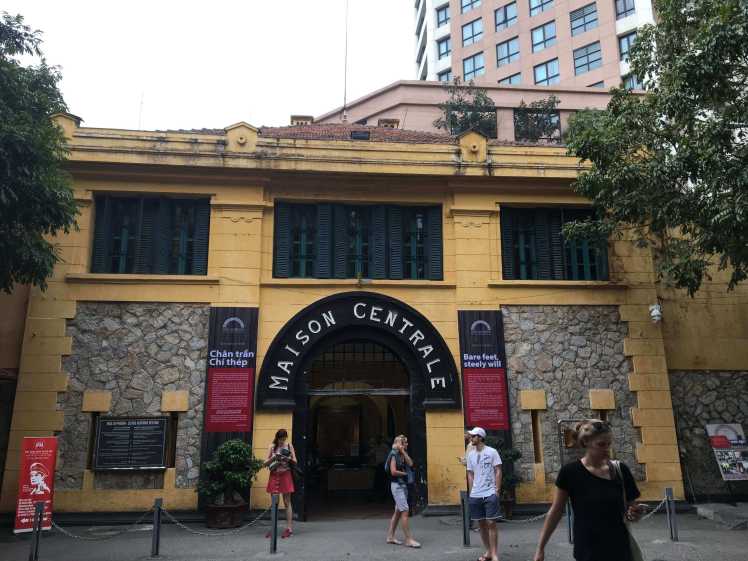

For the next two days, Aaron and I toured Hanoi, mostly by foot since much of the history and things to see are concentrated in the city center. One thing you realize quickly is that Hồ Chí Minh is revered in Vietnam (fair to say he would be to the Vietnamese what George Washington and Abraham Lincoln are for Americans). He lies in a mausoleum in central Hanoi which we thought we would go visit. It is no exaggeration to say that the line of folks to visit “Uncle Hồ” was a mile long. Consequently, we decided to skip out on this and opted instead to visit his museum next door. I took away two distinct themes from this visit, both of which I would reflect on throughout the rest of the trip. The first is that, being a communist country, they try hard to portray that the communist ideology is responsible for their newfound success as an independent country. The reality everywhere you go however, is that capitalism is alive and well and there is no real evidence that the communist ideology is really adhered to. In other words, it is simply a one party political system, but its economy is, for the most part, dependent on the free market. The second theme is that this country has gone through some very traumatic birth pains. From the Japanese occupation during WWII, the war with the French to shake off the colonial chains, the war with the United States resulting from their misfortune of being the first “domino” and then brief wars with Cambodia and China, Vietnam’s recent history is not one of peace and brotherly love. As a result, you would think that folks here would harbor some ill will to those they fought against, especially Americans. That was never the case however. Everywhere we went, people were quite friendly, willing to help and seemed quite happy that we would come to visit their country. I did mention that free market thing, right? Seriously, we felt welcomed everywhere we went and many folks, especially the kids, loved to smile and say “hello.”

Our next stop on the trail was Hạ Long Bay, which together with its neighbor Lan Hạ Bay, contain one of the largest karst formations in the world. Of course you can see some of these formations standing on the shore, but the best way to experience this geographical beauty is by boat. We hopped on one of the many cruise boats with fourteen fellow travelers for a three day trip in the bays. For me, this was the highlight of the trip given my affinity for boats and being on the water. The scenery was nothing short of fantastic with the mountains rising out of the water, the jungles, wildlife, sunrises/sunsets and white sand beaches. We had the opportunity to explore caves, climb to the top of a mountain, kayak in lagoons and hike and bike through an island jungle. We saw fishing communities where families lived in floating dwellings, surrounded by the mountains and their fish pens. The kids were even collected by a “school boat” to take them to a land based school. Just fascinating to see such a different environment from the one we are used to.
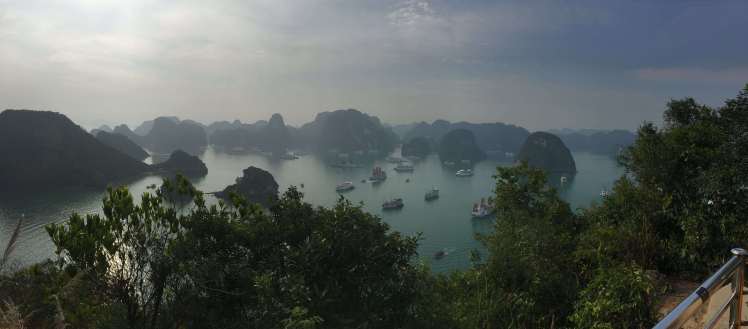

After three wonderful days on the water, our journey took us back to Hanoi to catch an overnight train to the city of Huế, about 675 kilometers southeast of Hanoi. For a war history buff, Huế has some significance as being home to one of the fiercest battles during the Tet Offensive of 1968 and is located just south of the de-militarized zone (DMZ), that, despite its name, also saw some of the worst fighting of the war. For any other history buff, Huế also happens to be the seat of power of the Nguyễn dynasty that ruled Vietnam from 1802 to 1945. The city is famous for its walled citadel that was the seat of the empire. Though many of the buildings within were destroyed in 1947 (French war) and 1968 (American war), they are doing a remarkable job restoring the place. We spent a few hours walking around inside the walled citadel…it was certainly hard to imagine the violent history of this peaceful place. Outside of the citadel, Huế was a nice city, bisected by the Perfume River, which we took a little boat ride on. The sunset over the mountains to the west, a visit to the Thiên Mụ pagoda and the lanterns floating on the river just after dark made for a memorable trip. Huế was quite a bit smaller and less dense than Hanoi and had more of a hip feel to it. The economic development here was just as evident though. On our second day in Huế, we decided to take a trip up to the DMZ to see the Vietnamese countryside and imagine the experience of US troops here 50 years ago. While there are a couple of monuments and a small museum, the country seems to have moved on. One thing we learned later in Saigon, was that there was still a tremendous amount of unexploded ordnance in the region. The most fascinating thing about this tour was the Vịnh Mốc tunnels which housed an entire village 30 meters underground as they sheltered from aerial bombings. Humans will go to great lengths to survive!


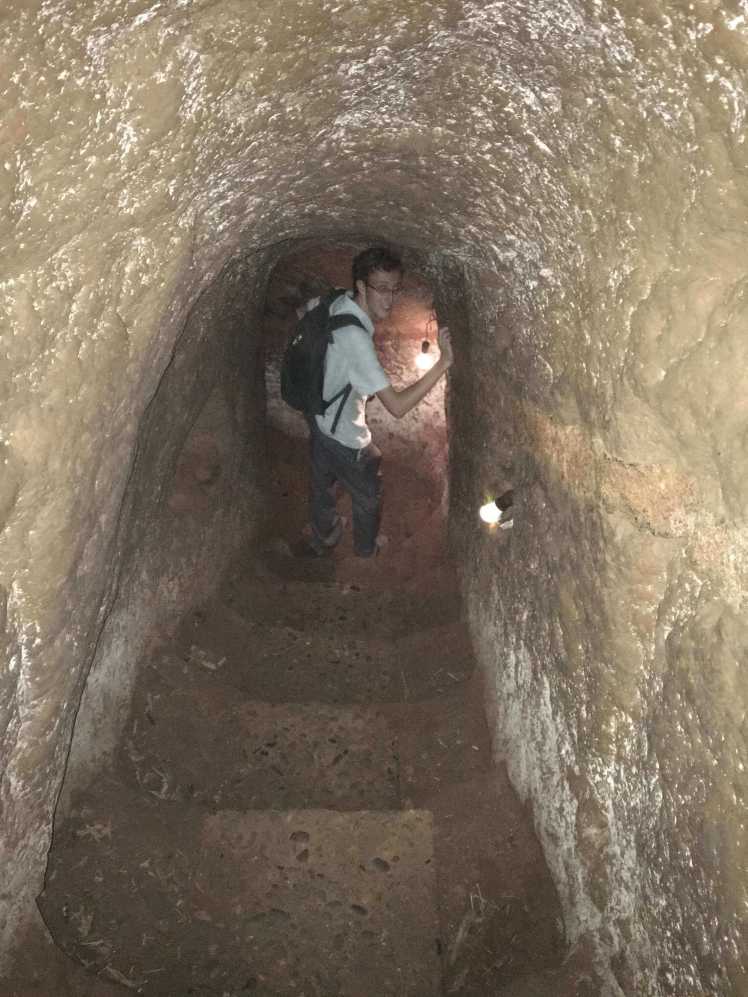

After Huế, it was back on the train to head further down the coast to the city of Đà Nẵng, Vietnam’s fourth largest city. I had heard of Đà Nẵng many years ago as my uncle’s A-4 squadron was based there. It did not quite match the picture in my mind though. Đà Nẵng today is a modern city that seems to be growing fast. It was also split by a river, the Hàn, and they have done a very nice job with riverfront promenades with restaurants and shops alongside. The most prominent feature is a steel dragon that forms part of the structure of one of the bridges. At night the city lights up with a variety of colors as does the dragon bridge. We stayed over on the beach side of the city. The beach was really nice but was lined with high rise hotels and overpriced restaurants (one lesson that we learned earlier in our trip and applied here was: never eat in a restaurant that does not have the prices on the menu!).

The primary reason for our stop in Đà Nẵng, though, was to make a day trip to the small town of Hội An, about 30 km south of Đà Nẵng. One thing you notice on the drive along the coast is the large number of luxury resorts, both in operation and under construction, with names like Wyndham, Sheraton, etc. (US troops called this stretch of coast China Beach – a popular spot for R&R). Hội An was a unique little town that kind of had the feel of small coastal tourist towns in California. There were art galleries, small museums, shops, temples and old houses on narrow streets with lots of colorful vegetation. In the evening, it was quite charming as the colorful paper lanterns hanging across the streets lit up giving it a very festive atmosphere. What is amazing though is that being situated in a little river delta, it floods quite often, inundating the shops and buildings, sometimes up to the roof. The last flood was in the fall of 2016…you would never know it though; they must be good at flood remediation!
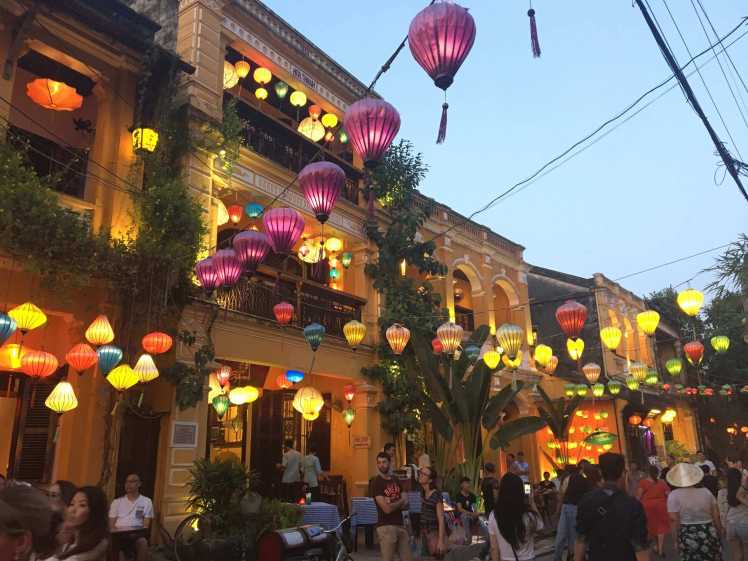
After a quick motorbike ride back to Đà Nẵng, it was time for another overnight train down the coast, this time to the city of Nha Trang, about 525 kilometers south of Đà Nẵng. Nha Trang is known for its beautiful crescent beach with scenic mountains and islands nearby. However, the first thing we noticed when we got there was that much of the signage included Russian. Turns out this is a big destination for Russian tourists and indeed, we saw quite a lot of them on the beach. As I’ve mentioned economic growth throughout this post, the example from Nha Trang was that from the top of our twenty-story hotel, I counted at least twenty high-rise buildings under construction. Even the large airbase built to train French pilots and later used as a US airbase was being torn up and under various stages of redevelopment.

After having spent a few days on the coast enjoying the beaches, our next destination was the town of Đà Lạt, roughly 130 kilometers west of Nha Trang. Đà Lạt is a mountain town so despite the distance, the trip was not a quick one. In fact, we took a bus whose driver must have thought he was piloting a Ferrari up the switchback road. For some folks on the bus, the barf bags came out about halfway there! Anyway, if you didn’t mind the ride, the jungle and mountain scenery was nice. We arrived in Đà Lạt around mid-day and the temperature was about twenty degrees cooler than what we left behind at the coast. While Đà Lạt is known for its coffee, we saw a lot of agriculture in the area and the markets were full of fresh produce. This is a quaint little mountain town with a nice lake in the city center which we enjoyed walking around. In the evening, the streets near our hotel turned into a busy outdoor market where you could find a variety of merchandise, food, and entertainment. By far the most interesting thing we visited was a coffee shop called “The Maze.” It is hard to describe a building that is constructed as a maze that scaled at least five stories but Alice in Wonderland comes to mind. By the time we figured out how to get to the highest point, we enjoyed a spectacular view of the city, lake, and surrounding mountains.
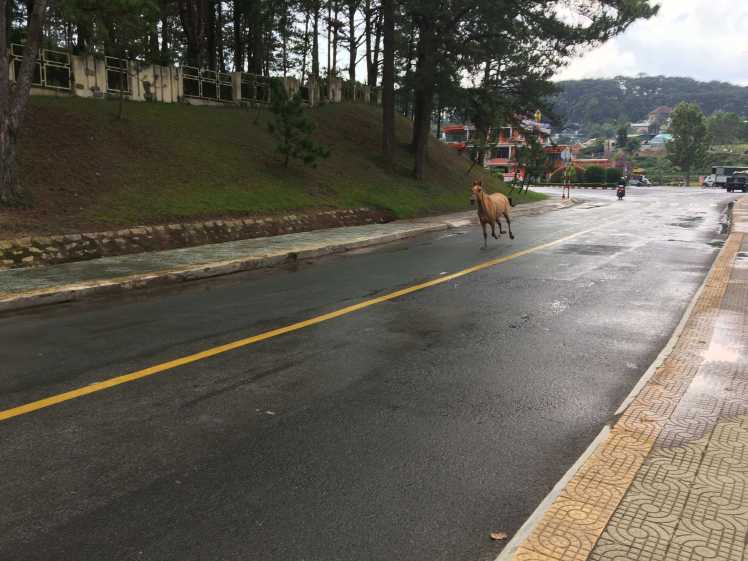
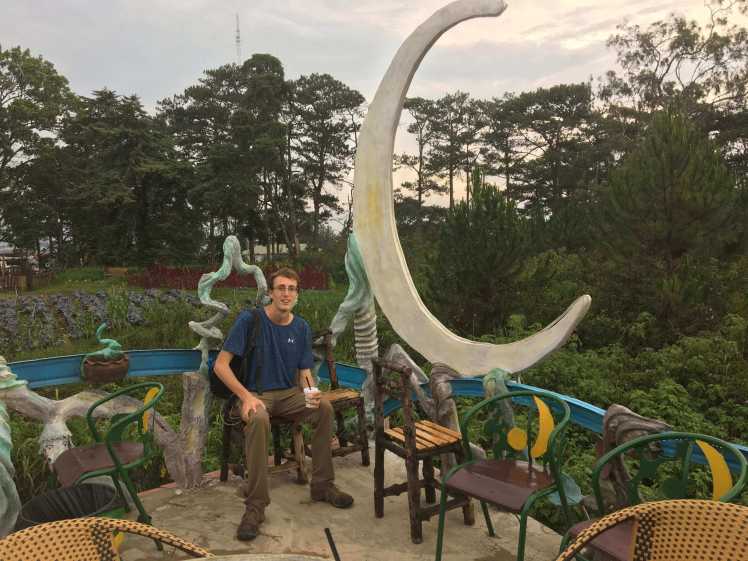
To save some time, we had decided to fly the short distance from Đà Lạt to Saigon. After the bus to Đà Lạt experience, we realized the true value of our decision! Flying into Saigon, you can clearly see that this is the largest city in Vietnam. If it were in the US, it would easily be our largest city. While there were still quite a few motorcycles here, there were noticeably more cars than anywhere we went and consequently, more traffic. However, as we were staying down in the city center (District 1) and walked to everything we wanted to see, this did not bother us much. Saigon has a much different feel than the other cities we visited. It was more cosmopolitan and appeared more international. We spent my final two days in Vietnam visiting some of the museums here, the Reunification Palace, and did some souvenir shopping. The palace is a familiar sight from old news footage during the war, as it was the seat of the South Vietnamese government. They have really preserved this building nicely, complete with a Huey helicopter on the rooftop. Though it was built in the 60s, it really is a nice palace. Of course, the audio tour helped us understand what we were looking at but it wasn’t hard to imagine the place as it was during the war. One of the most sobering places we visited in the country had to be the war museum in Saigon. History is displayed differently depending on your side of it and this was certainly the case here. Despite this, it was clear that the wars fought in Vietnam between 1945-1980 were incredibly destructive and traumatic, not only for the Vietnamese but also for their adversaries, namely the French and Americans.

Shopping is not really my thing but since we were determined to get some souvenirs for the folks back home, we found ourselves deep inside a very large market. As I mentioned earlier, Western tourists are rich targets for anyone selling anything, especially when they come into a place full of salespeople. What was fun was negotiating purchases with the women in these markets (most all of the salespeople were women). They would go from friendly to pushy to pouty over the course of the negotiation and really make you feel like you were taking advantage of them. All part of the schtick I guess…we closed the sale on all but one proposed transaction.

Hard to believe the two weeks in Vietnam passed so quickly. There is so much to see and do here that I feel like we only scratched the surface. Thank you, Aaron, for giving me the opportunity to visit and for the great company on the trip! To readers of this blog, if you are looking for a very economical place, with friendly folks, beautiful scenery and that is easy to get around, I would recommend a visit to Vietnam. I will certainly try to make a return trip, maybe next time joining the locals and making the tour on a motorcycle!
Thank you for sharing, Dad! I had a great time, and I’m glad we had the opportunity to explore Việt Nam together!

So interesting! Glad you and Aaron had this experience
LikeLiked by 1 person